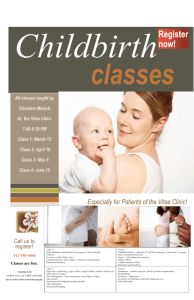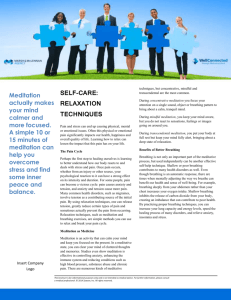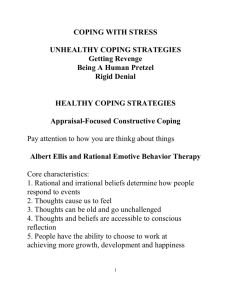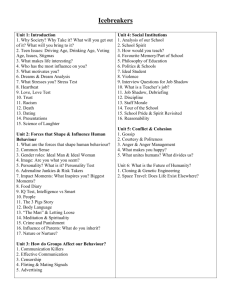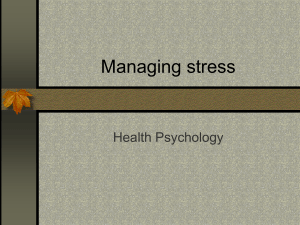File - Sandra Alley
advertisement
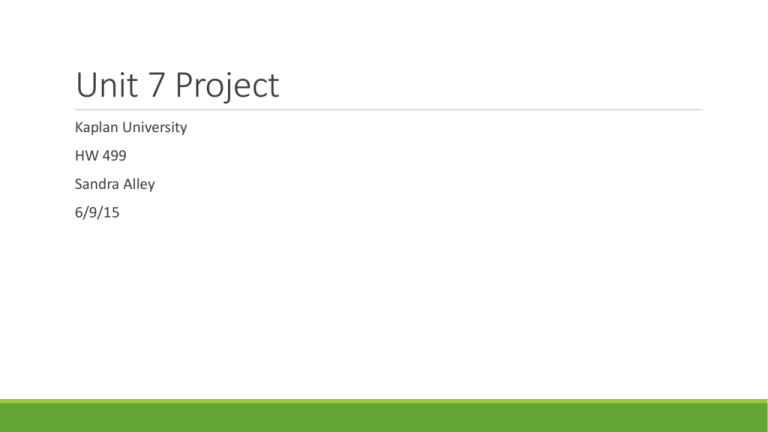
Unit 7 Project Kaplan University HW 499 Sandra Alley 6/9/15 The Nature of Stress Allostasis – the brain coordinating body wide changes, often including changes in behavior During Stress: ◦ ◦ ◦ ◦ ◦ Digestion is slowed Growth and tissue repair is curtailed Sex drive decreases Immunity is inhibited Shifts occur in cognitive and sensory skills ◦ It is hard to fix 1 major problem in the body without knocking something else out of balance. Continued… Stress increases the risk of getting diseases. There are many different types of stress Holistic Wellness ◦ ◦ ◦ ◦ Emotional well being Mental well being Physical well being Spiritual well being ◦ Balance and harmony of the previous four means the whole is greater than the sum of the parts. Managing Stress Holistically Knowledge of the body’s reaction to stress Knowledge of (all 4 parts) factors associated with stress Utilization of effective coping techniques Regular practice of relaxation techniques Exercise: Personal Stress Inventory Top 10 Stressors Journal: Are You Stressed Central Nervous System and Peripheral Nervous System Affected By Stress 75% to 90% of all visits to primary care physicians are for stress related complaints/disorders Health related problems are aggravated by stress Nervous System Related Disorders ◦ ◦ ◦ ◦ ◦ ◦ Bronchial asthma Tension headaches Migraine headaches TMJ (temporomandibular joint dysfunction) IBS (irritable bowel syndrome) Coronary heart disease Immune System Related Disorders Common cold Influenza Allergies Reumatoid Arthritis Lupus Ulcers Cancer Continued… Stress is linked to immune system and diseases. Stress management is a means of dealing with stress – physical and psychological techniques used to help people cope with strain and anxiety. Exercise: Immediate, Intermediate and Prolonged Stress Effects Journal: Physical Symptoms Questionnaire Stress Emotions Anatomy of Anger ◦ ◦ ◦ ◦ ◦ ◦ ◦ ◦ ◦ Rage Hostility Impatience Fear Envy Jealousy Prejudice Guilt frustration Continued… Unresolved anger issues have a direct connection to many chronic health conditions. Creative Anger Strategies ◦ ◦ ◦ ◦ ◦ ◦ ◦ ◦ ◦ ◦ ◦ ◦ Know your anger style Learn to monitor it Learn to de-escalate your anger Learn to out think your anger Get comfort with all your feelings Plan ahead Develop a strong support system Develop realistic expectations Learn problem-solving techniques Stay in shape Turn complaints into requests Practice art of forgiveness Basic Human Fears Fear of: ◦ ◦ ◦ ◦ ◦ ◦ Failure Rejection The unknown Death Isolation Loss of self-dominance ◦ Fearless Living Rules ◦ Fine-tune expectations ◦ Stop making excuses ◦ Stop complaining ◦ Don’t beat yourself up Emotions Healthy Emotions: ◦ The ability to feel and express the entire range of human emotions – control them, not controlled by them. Unhealthy Emotions: unresolved issues of anger/fear that deny the full experience of all emotions in the range of human emotional spectrum. 4 Pillars of Spirituality: Relationships (internal/external) Values Meaningful purpose in life The Divine Mystery Human Spirituality Differ from Religion SPIRITUALITY RELIGION Inclusive Exclusive Experiential Based on rules, regulation and dogma Direct one to divine Direct one to divine Continued… Exercises: Anger Recognition Checklist Journal: The Psychology of Your Studies Personality Traits There are many different personalities. ◦ ◦ ◦ ◦ ◦ Type A Helpless-Hopeless Personality The Hardy Personality Survivor Personality Type R Personality ◦ Managing Stress ◦ Control – personal ◦ Commitment – reflection of one’s willpower ◦ Challenge- sense of adventure ◦ (these traits can be learned) Continued… Focusing – recognize the body’s signals of oncoming stress Reconstruction – reinterpretation of a stressor (negative to positive) Compensation – cultivate and utilize one’s strengths in times of need, rather than claiming victimization Resiliency – pick yourself up after being knocked down Self-esteem – sense of underpinning self-values, self-acceptance and self-love; a powerful buffer against perceived threats A person’s level of self esteem appears to be a critical factor in how people respond to stress regardless of personality type. Exercise: Your Personal Value System Journal: Under the Gun: Stress and Personality Dealing with Stress: Coping Strategies Human Behavior Styles ◦ Passive ◦ Aggressive ◦ Assertive ◦ Coping Techniques ◦ Humor – a defense mechanism – decreases anxiety and increases pleasure; also balances out common feelings of fears and frustrations. ◦ Retail – shop to alleviate stress, filling emptiness with material possessions and leaving a large debt. ◦ Time management – prioritization, scheduling and execution of daily responsibilities to a level of personal satisfaction. ◦ Power of Positive Affirmations ◦ Words/phrases we say to ourselves to keep our mind centered rather than drifting toward negative thought processes. Purpose of Coping Skills To reduce harmful environmental conditions Tolerate/adjust to negative events/realities to maintain a positive self-image To maintain emotional equilibrium To continue satisfying relationships with others Exercises: In Search of the Proverbial Funny Bone Journal: Value Assessment and Clarification Relaxation Techniques Purpose of Relaxation Techniques: ◦ Deactivate the body’s sensory system ◦ Decrease stimuli ◦ Replace with non-threatening sensations that promote relaxation response ◦ Diaphragmatic Breathing (cornerstone for many other techniques) ◦ Assume comfortable position ◦ Concentrate solely on breathing ◦ Visualize breathing cycle ◦ Mediation (increased concentration that leads to increased awareness) ◦ A proven means to decrease sensory bombardment thus regaining mental homeostasis. Many Types of Meditation Exclusive Meditation Inclusive Meditation Mindfulness Meditation Insightful Meditation Steps to Meditation ◦ ◦ ◦ ◦ Quiet space Sit/lay down Focus on breathing Select a mental device Mental Imagery/Visualization Mental Imagery – using imagination to observe images created by the unconscious mind for relaxation, behavior change, and physical restoration. Visualization – self directed exercise in mental imagery; consciously creating images of success, healing, or relaxation for the purpose of self-improvement. How to Meditate ◦ ◦ ◦ ◦ Concentrate on breathing Use mantras Focus on object/idea Empty mind 4 Components Found in Every Relaxation Technique Quiet Environment Mental Device Passive Attitude Comfortable Position Exercise: Bridging the Hemispheres of Thought Journal: Dolphin Breath Meditation Nutrition and Stress Eat for a Healthy Immune System ◦ ◦ ◦ ◦ ◦ ◦ ◦ ◦ ◦ ◦ ◦ Consume a good supply of antioxidants Consume a good supply of fiber Drink plenty of fresh, clean water Decrease consumption of pesticides, fungicides, herbicides and fertilizers found on and in produce Consume adequate supply of complete proteins Decrease/eliminate processed foods Decrease/eliminate antibiotic and hormones Consume a good supply of omega-3’s Decrease intake of saturated fats Decrease/avoid intake of trans fatty acids Eat a variety of food colors Continued… Consume a good balance of foods with proper PH Decrease intake of total % of fats Replenish nutrients consumed by the stress response Decrease consumption of simple sugars Decrease/avoid excitotoxins (Aspartame, NutraSweet and MSG) Moderate alcohol consumption Prepare food in best possible way Eat organic produce and free-range meats whenever possible Avoid GMO’s (genetically modified organisms) Continued… Use herbal therapies to boost the immune system. Eat at least 1 meal a day for your immune system. Exercise: Nutritional Eating Habits Journal: Stress- Related Eating Behaviors Physical Exercise and Activity Physical Exercise is Stress Response ◦ ◦ ◦ ◦ ◦ ◦ Increased heart rate Increased blood pressure Increased rate of breathing Increased metabolic activity Increased muscle contraction Increased perspiration ◦ Why is it different from the stress response? ◦ Lowered resting heart rate ◦ Lowered resting blood pressure ◦ Lowered rate of breathing ◦ Quicker return to homeostasis Types of Exercise Anaerobic – muscle strength/toning Aerobic – cardiovascular Components of Fitness ◦ ◦ ◦ ◦ ◦ ◦ Cardiovascular endurance Muscular strength Flexibility Agility Power balance Physical Conditioning Frequency (days/weeks) Intensity (target heart rate) Duration (minutes/session) Phase of Workout ◦ Warm up ◦ Stimulus (target zone) ◦ Cool down Steps to Initiate a Fitness Program Start cautiously and progress moderately Pick an activity you enjoy Specific time of day Exercise with the right clothes and equipment Have a strong support group Set personal fitness goals Use caution to prevent injuries Physical Exercise burns off stress hormones Continued… Exercise: Your Circadian Rhythms Journal: My Body, My Physique Managing Stress Additional Coping Techniques: ◦ ◦ ◦ ◦ ◦ ◦ ◦ Information Seeking Social Orchestration Social Support Groups Hobbies Forgiveness Dream Therapy Prayer ◦ Techniques for Stress Management Professionals ◦ Tai Chi ◦ Progressive Muscular Relaxation ◦ Clinical Biofeedback Continued… Exercise: Defining Your Support Group Journal: Sweet Forgiveness References Seaward, Brain Luke. (2009) Managing Stress: Principles and Strategies for Health and WellBeing 6th Edition. Sudbury, MA: Jones and Bartlett Publishers. Sapolsky, Robert M. (1998) Why Zebras Don’t Get Ulcers: The Acclaimed Guide to Stress, StressRelated Diseases, and Coping 3rd Edition. New York, NY; Holt Publishing. Kaplan University. Power Point Presentations. HW 410 Stress: Critical Issues in Management and Prevention.


